Exercises (1839)
Lateral raising and lowering of the arms in prone position ► prone T
Power
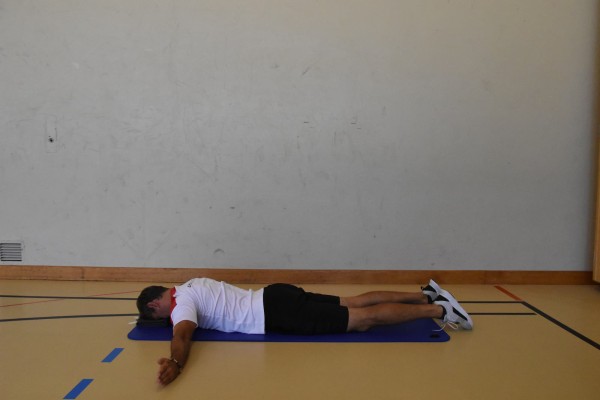
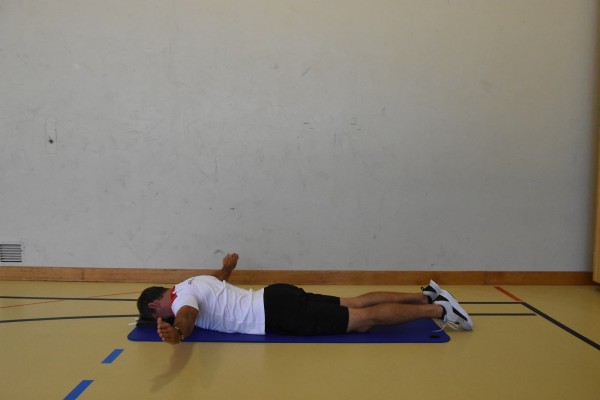
Lie on your stomach with your forehead resting on a folded cloth, feet shoulder-width apart, arms pointing to either side (T-position), arms stretched and completely relaxed. From this position, pull the shoulder blades together and raise the arms until the elbows are at shoulder height and the arms are parallel to the floor (palms facing forward or downward). Keep your arms straight throughout the entire movement. Exhale in the end position, hold the position for a moment, then inhale and lower your arms back to the starting position.
Attention:
Only the arms should be raised, nothing else - aim to isolate the upper back.
Harden:
Do not lower your arms completely; hold additional weight in your hands or on your arms.
Variation I:
Alternately raise one arm (instead of both at the same time).
Variation II:
Position on a flat bench or an incline bench.
2 weight cuffs/2 weight balls/dumbbells ► Make the exercise more difficult (additional weight)
Lateral raising and lowering of the arms in prone position ► prone T raise / prone lateral raise
Power
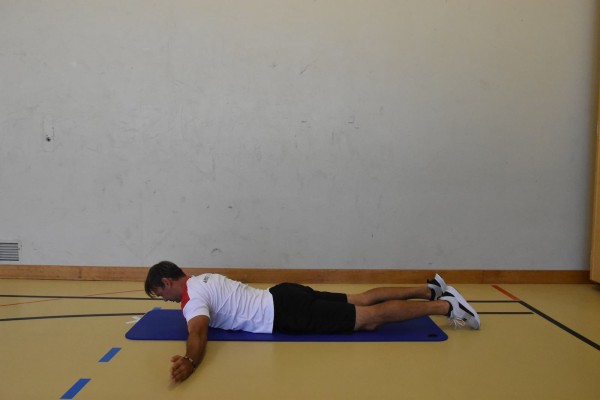
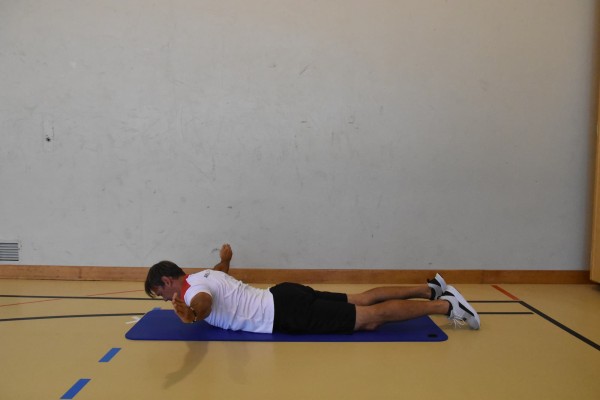
Prone position with upper body slightly raised, feet shoulder-width apart, arms pointing to either side (T-position), arms stretched and completely relaxed. From this position, pull the shoulder blades together and raise the arms until the elbows are at shoulder height and the arms are parallel to the floor (palms facing forward or downward). Keep your arms straight throughout the entire movement. Exhale in the end position, hold the position for a moment, then inhale and lower your arms back to the starting position.
Attention:
Only the arms should be raised, nothing else - aim to isolate the upper back.
Harden:
Do not lower your arms completely; hold additional weight in your hands or on your arms.
Variation I:
Alternately raise one arm (instead of both at the same time).
Variation II:
Position on a flat bench or an incline bench.
2 weight cuffs/2 weight balls/dumbbells ► Make the exercise more difficult (additional weight)
Lateral raising and lowering of the arms in prone position ► prone W
Power
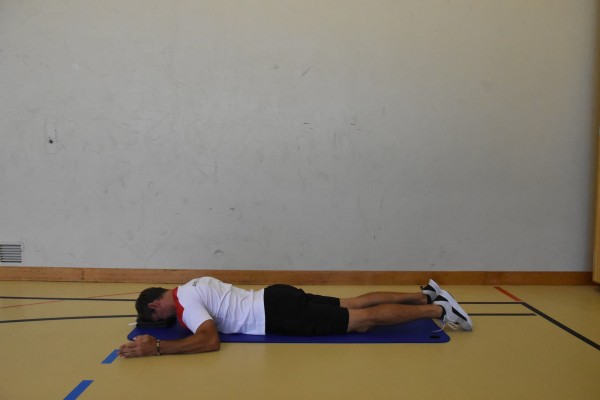
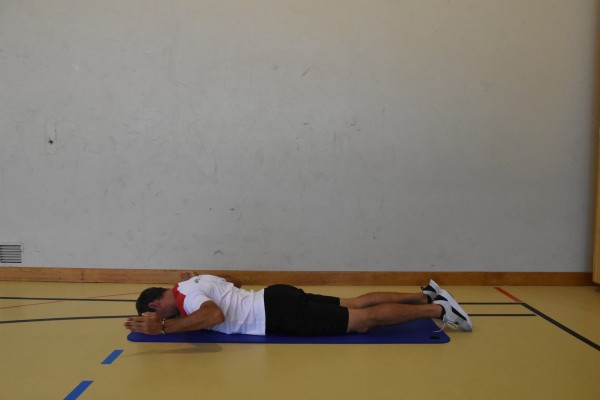
Lie on your stomach with your forehead resting on a folded cloth, feet shoulder-width apart, arms bent, elbows close to your body, arms pointing diagonally forwards to the respective side (W position), arms completely relaxed. From this position, pull your shoulder blades together and raise your arms until your elbows are at shoulder height and your arms are parallel to the floor (palms facing inwards at an angle). Exhale in the end position, hold the position for a moment, then inhale and lower your arms back to the starting position.
Attention:
Only the arms should be raised, nothing else - aim to isolate the upper back.
Harden:
Do not lower your arms completely; hold additional weight in your hands or on your arms.
Variation I:
Alternately raise one arm (instead of both at the same time).
Variation II:
Position on a flat bench or an incline bench.
2 weight cuffs/2 weight balls/dumbbells ► Make the exercise more difficult (additional weight)
Lateral raising and lowering of the arms in prone position ► prone raise
Power
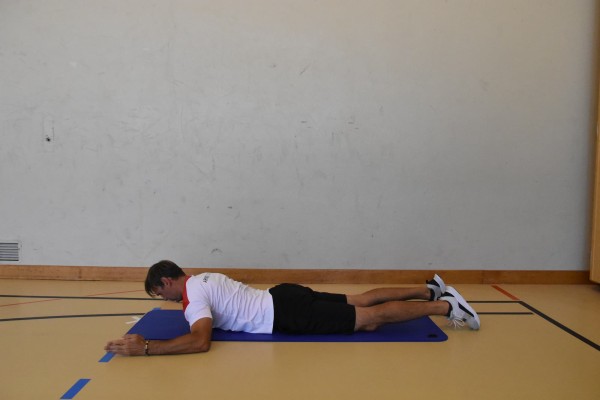
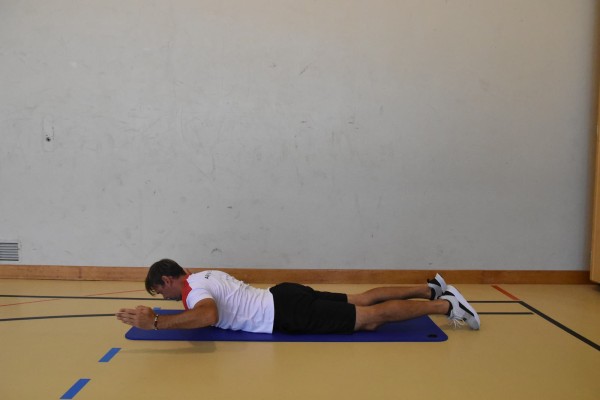
Prone position with upper body slightly raised, feet shoulder-width apart, arms bent, elbows close to your body, arms pointing diagonally forwards to the respective side (W position), arms completely relaxed. From this position, pull your shoulder blades together and raise your arms until your elbows are at shoulder height and your arms are parallel to the floor (palms facing inwards at an angle). Exhale in the end position, hold the position for a moment, then inhale and lower your arms back to the starting position.
Attention:
Only the arms should be raised, nothing else - aim to isolate the upper back.
Harden:
Do not lower your arms completely; hold additional weight in your hands or on your arms.
Variation I:
Alternately raise one arm (instead of both at the same time).
Variation II:
Position on a flat bench or an incline bench.
2 weight cuffs/2 weight balls/dumbbells ► Make the exercise more difficult (additional weight)
Lateral raising and lowering of the arms in prone position ► prone weighted T
Power
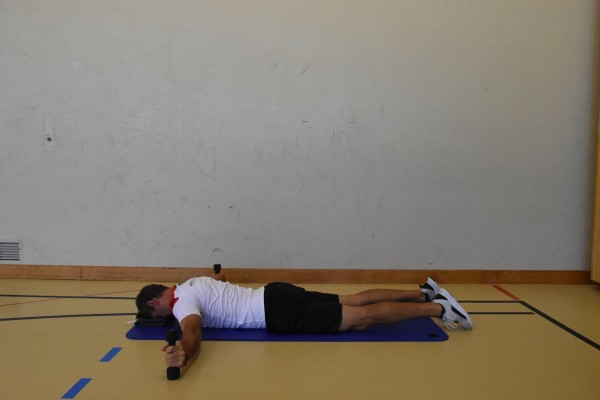
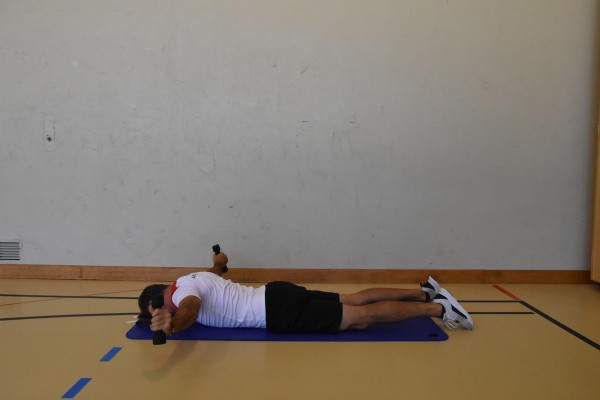
Lie on your stomach with your forehead resting on a folded cloth, feet shoulder-width apart, arms pointing to either side (T-position), arms stretched and completely relaxed. Hold a (light) dumbbell in each hand. From this position, pull the shoulder blades together and raise the arms until the elbows are at shoulder height and the arms are parallel to the floor (palms facing down). Keep your arms straight throughout the entire movement. Exhale in the end position, hold the position for a moment, then inhale and lower your arms back to the starting position.
Attention:
Only the arms should be raised, nothing else - aim to isolate the upper back.
Harden:
Do not lower your arms completely.
Variation I:
Alternately raise one arm (instead of both at the same time).
Variation II:
Position on a flat bench or an incline bench.
2 weight cuffs/2 weight balls/dumbbells
Lateral raising and lowering of the arms in prone position ► prone weighted T raise / prone weighted lateral raise
Power
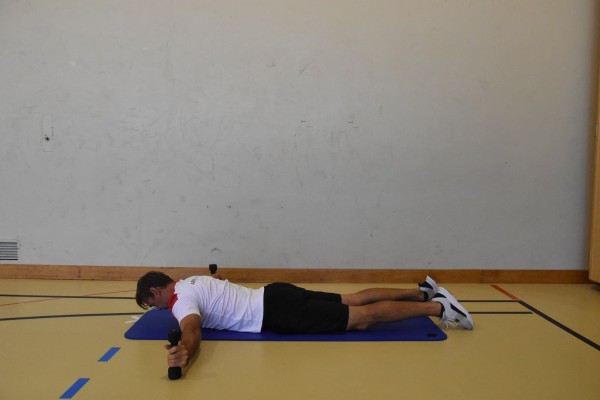
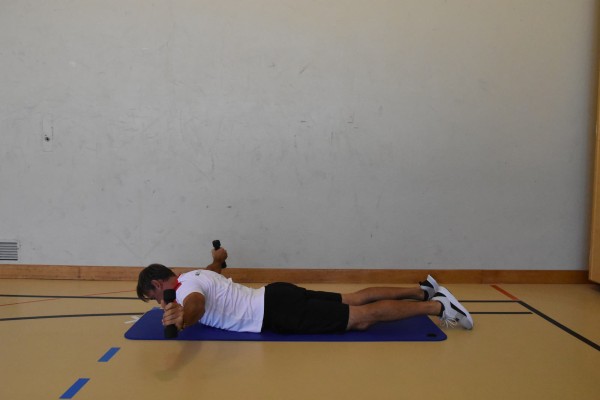
Prone position with upper body slightly raised, feet shoulder-width apart, arms pointing to either side (T-position), arms stretched and completely relaxed. Hold a (light) dumbbell in each hand. From this position, pull the shoulder blades together and raise the arms until the elbows are at shoulder height and the arms are parallel to the floor (palms facing down). Keep your arms straight throughout the entire movement. Exhale in the end position, hold the position for a moment, then inhale and lower your arms back to the starting position.
Attention:
Only the arms should be raised, nothing else - aim to isolate the upper back.
Harden:
Do not lower your arms completely.
Variation I:
Alternately raise one arm (instead of both at the same time).
Variation II:
Position on a flat bench or an incline bench.
2 weight cuffs/2 weight balls/dumbbells
Lateral raising and lowering of the arms in prone position ► prone weighted W
Power
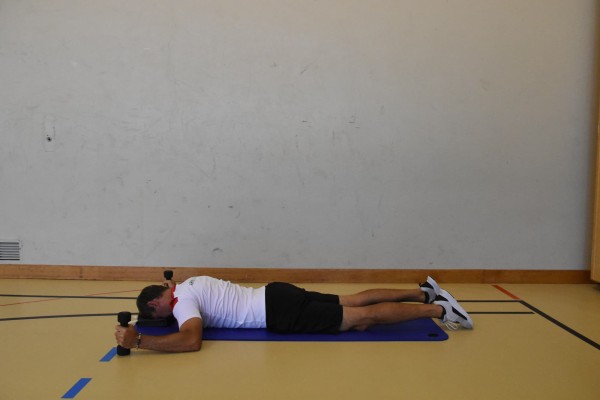
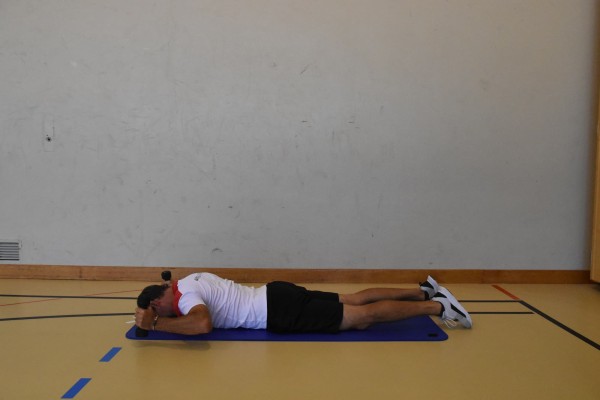
Lie on your stomach with your forehead resting on a folded cloth, feet shoulder-width apart, arms bent, elbows close to your body, arms pointing diagonally forwards to the respective side (W position), arms completely relaxed. Hold a (light) dumbbell in each hand. From this position, pull your shoulder blades together and raise your arms until your elbows are at shoulder height and your arms are parallel to the floor (palms facing inwards at an angle). Exhale in the end position, hold the position for a moment, then inhale and lower your arms back to the starting position.
Attention:
Only the arms should be raised, nothing else - aim to isolate the upper back.
Harden:
Do not lower your arms completely.
Variation I:
Alternately raise one arm (instead of both at the same time).
Variation II:
Position on a flat bench or an incline bench.
2 weight cuffs/2 weight balls/dumbbells
Lateral raising and lowering of the arms in prone position ► prone weighted W raise
Power
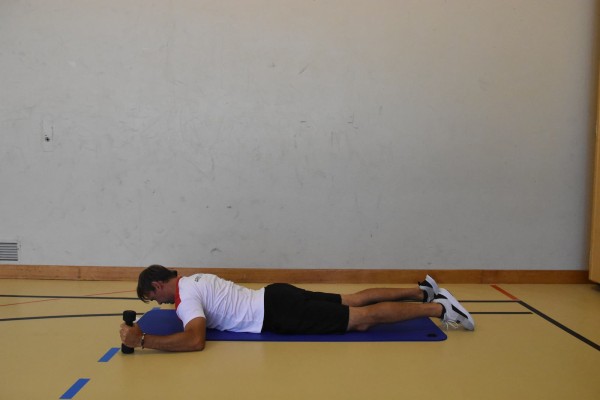
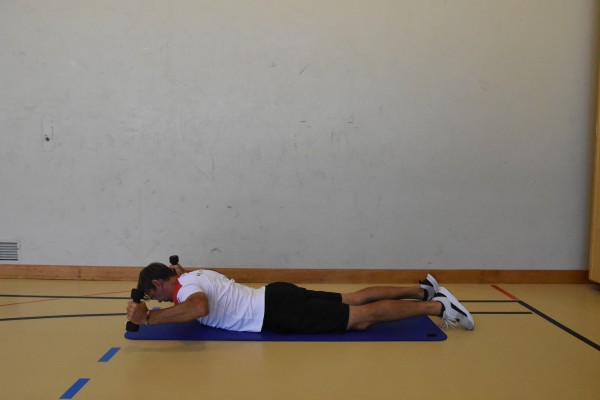
Prone position with upper body slightly raised, feet shoulder-width apart, arms bent, elbows close to your body, arms pointing diagonally forwards to the respective side (W position), arms completely relaxed. Hold a (light) dumbbell in each hand. From this position, pull your shoulder blades together and raise your arms until your elbows are at shoulder height and your arms are parallel to the floor (palms facing inwards at an angle). Exhale in the end position, hold the position for a moment, then inhale and lower your arms back to the starting position.
Attention:
Only the arms should be raised, nothing else - aim to isolate the upper back.
Harden:
Do not lower your arms completely.
Variation I:
Alternately raise one arm (instead of both at the same time).
Variation II:
Position on a flat bench or an incline bench.
2 weight cuffs/2 weight balls/dumbbells
Lateral raising and lowering of the arm while standing (left) ► lateral raise
Power
Individual work
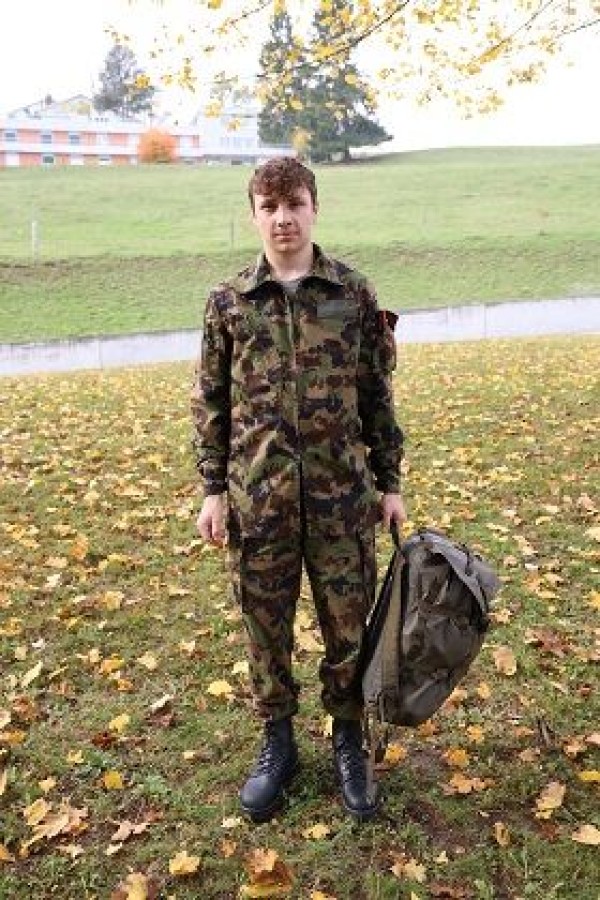
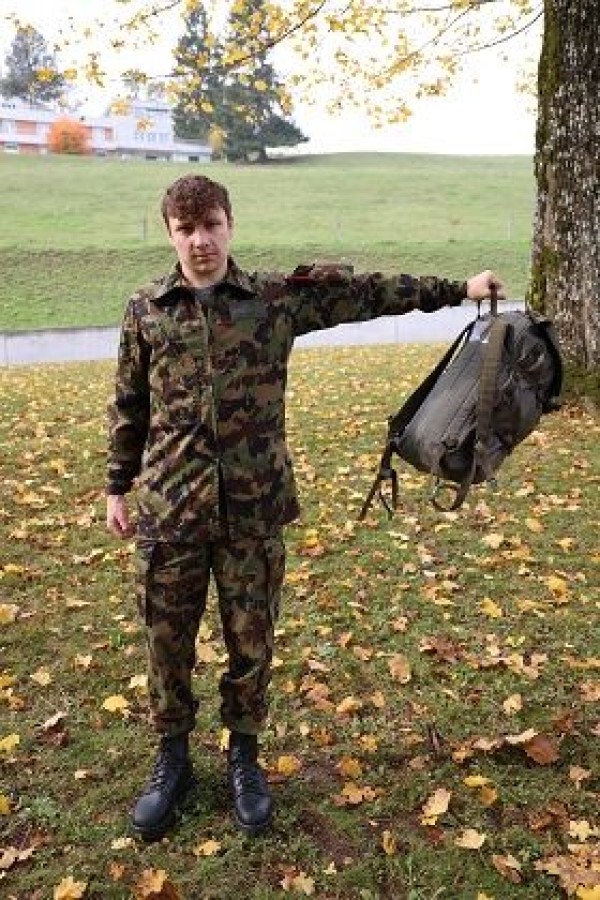
Stand upright, hold an object to the side of your body with your left hand (e.g. rucksack or sandbag) and then raise your arm sideways to shoulder height and lower it back to the starting position (side raise).
Attention:
Do not work with momentum, knees slightly bent, tense torso.
Lighten:
Less weight/load.
Harden:
More weight/greater load.
1 combat rucksack/sandbag (light)
1 PET bottle (1.5 litres)/helmet ► Make the exercise easier
1 sandbag (medium) ► Make the exercise more difficult (additional weight)
Lateral raising and lowering of the arm while standing (right) ► lateral raise
Power
Individual work

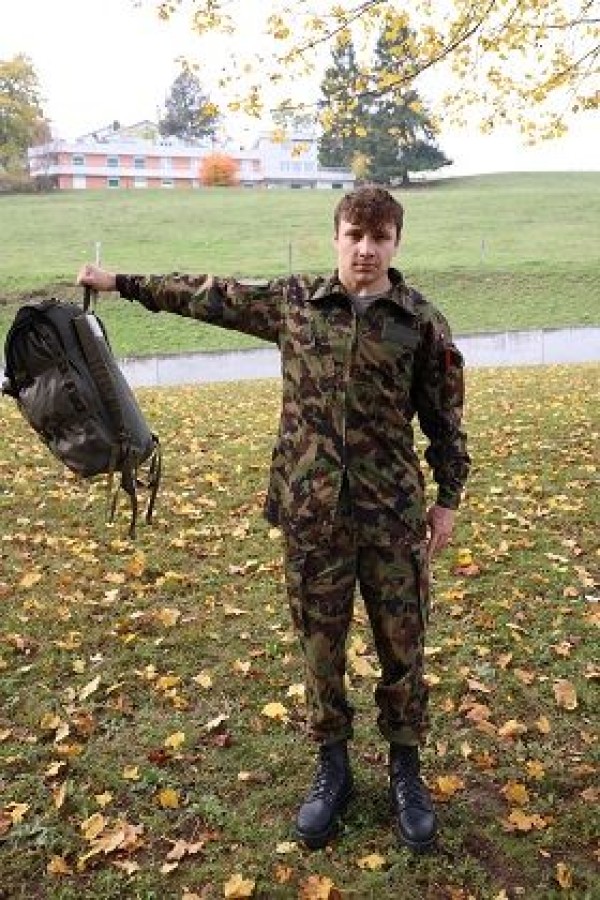
Stand upright, hold an object to the side of your body with your right hand (e.g. rucksack or sandbag) and then raise your arm sideways to shoulder height and lower it back to the starting position (side raise).
Attention:
Do not work with momentum, knees slightly bent, tense torso.
Lighten:
Less weight/load.
Harden:
More weight/greater load.
1 combat rucksack/sandbag (light)
1 PET bottle (1.5 litres)/helmet ► Make the exercise easier
1 sandbag (medium) ► Make the exercise more difficult (additional weight)
Lateral raising and lowering of the upper body in prone position ► lying back extension
Power
Individual work

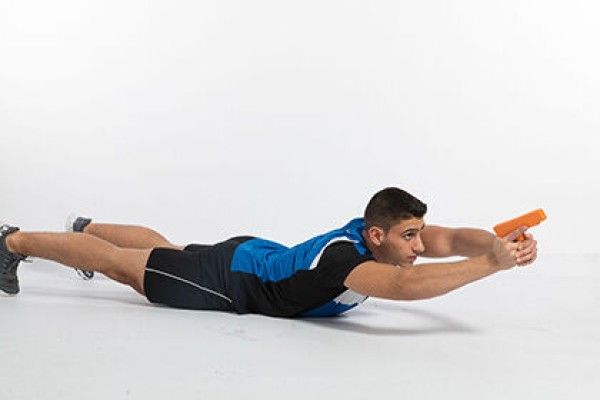
Prone position, arms bent in front of you, hold the pistol in both hands (lying position), move the pistol from one side to the other and simultaneously raise the upper body sideways.
Attention:
Do not lower the upper body completely.
Lighten:
Just hold the position.
1 pistol (neutralised)
Lateral raising and lowering of the upper body in prone position ► lying back extension / back bowes
Power
Individual work



Lying on your stomach with your arms bent in front of your head (or your hands closer together as you would hold a bowl, but palms facing upwards). Move your elbows approximately at shoulder height and your arms from side to side while lifting your upper body sideways (arms move in a semicircle, head/gaze follows the movement).
Attention:
Do not lower your upper body completely.
Lighten:
Lift the upper body less/rotate less to the side; only hold the centre position with the upper body raised.
Harden:
Hold additional weight on the arms or in the hands.
2 weight cuffs/weight balls/1 (medicine) ball/weight disc/1-2 dumbbells ► Make the exercise more difficult (additional weight)
Lateral raising and lowering of the upper body in prone position ► lying back extension / back bowes
Power
Individual work
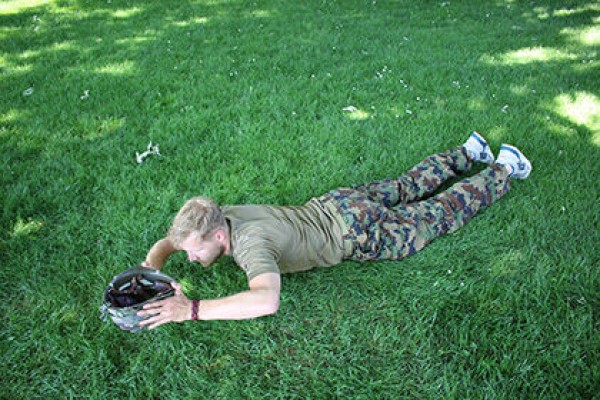

Lying on your stomach with your arms and legs stretched out and slightly raised from the floor (legs can also be put down). Hold an object (e.g. helmet) in your hands and move the object from one side to the other while lifting your upper body sideways (arms move in a semicircle, head/gaze follows the movement).
Attention:
Do not lower your upper body completely.
Lighten:
Do not hold an object in your hands; lift your upper body less/rotate less to the side; only hold the centre position with your upper body raised.
Harden:
Additional weight (e.g. place stones in your helmet/hold a backpack).
1 helmet
1 combat rucksack/3-4 stones ► Make the exercise more difficult (additional weight)
Lateral bending of the legs in the seat (left) ► knee to twist
Power
Individual work


When seated, use your arms to support your upper body, which is leaning slightly backwards, bend your outstretched, raised legs to the side (left) of your body (knees pointing diagonally upwards, feet by your buttocks) and return to the starting position (bend and stretch your legs and tilt them to the side).
Attention:
Do not put your legs down completely.
Lighten:
Do not fully extend your legs or always keep them bent (the smaller the angle, the easier).
Harden:
Additional weight on or between the legs.
2 weight cuffs/1 weight disc/(medicine) ball ► Make the exercise more difficult (additional weight)
Bending the legs sideways in the seat (right) ► knee to twist
Power
Individual work


When seated, use your arms to support your upper body, which is leaning slightly backwards, bend your outstretched, raised legs to the side (right) of your body (knees pointing diagonally upwards, feet by your buttocks) and return to the starting position (bend and stretch your legs and tilt them to the side).
Attention:
Do not put your legs down completely.
Lighten:
Do not fully extend your legs or keep them bent at all times (the smaller the angle, the easier).
Harden:
Additional weight on or between your legs.
2 weight cuffs/1 weight disc/(medicine) ball ► Make the exercise more difficult (additional weight)
Alternating lateral bending of the legs in the seat ► knee to twist
Power
Individual work



When seated, use your arms to support your upper body, which is tilted slightly backwards, bend your outstretched, raised legs to the side of your body (knees pointing diagonally upwards, feet by your buttocks) and return to the starting position (bend and stretch your legs and tilt them to the side). Switch sides after each exercise.
Attention:
Do not fully lower your legs.
Lighten:
Do not fully extend your legs or always keep them bent (the smaller the angle, the easier).
Harden:
Additional weight on or between the legs.
2 weight cuffs/1 weight disc/(medicine) ball ► Make the exercise more difficult (additional weight)
Bending the legs sideways in supine position (left) ► knee to twist
Power
Individual work

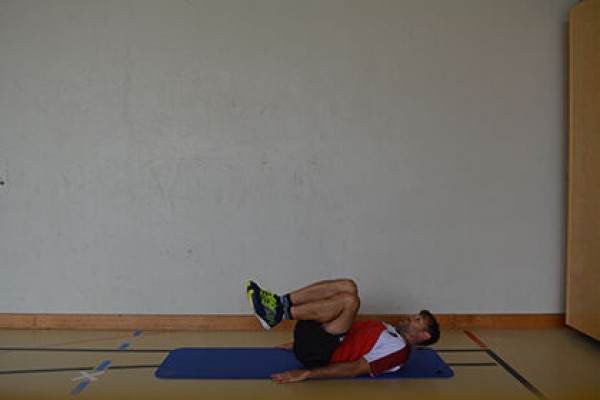
Back position, upper body flat on the floor, arms stretched out to the side on the floor (or place hands under the buttocks), bend outstretched, raised legs to the side (left) of the body (knees pointing diagonally upwards, feet by the buttocks) and return to the starting position (bend and stretch legs and tilt to the side).
Attention:
Do not put your legs down completely, keep your (lower) back in constant contact with the floor (consciously tense your stomach).
Lighten:
Do not fully extend your legs or always keep them bent (the smaller the angle, the easier).
Harden:
Additional weight on or between your legs.
2 weight cuffs/1 weight disc/(medicine) ball ► Make the exercise more difficult (additional weight)
Bending the legs sideways in supine position (right) ► knee to twist
Power
Individual work
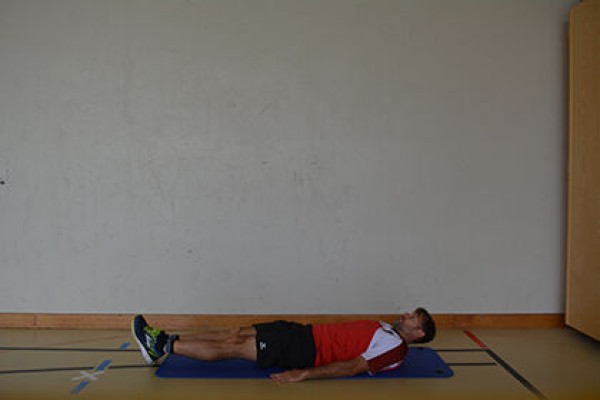

Back position, upper body flat on the floor, arms stretched out to the side on the floor (or place hands under the buttocks), bend outstretched, raised legs to the side (right) of the body (knees pointing diagonally upwards, feet by the buttocks) and return to the starting position (bend and stretch legs and tilt to the side).
Attention:
Do not put your legs down completely, keep your (lower) back in constant contact with the floor (consciously tense your stomach).
Lighten:
Do not fully extend your legs or always keep them bent (the smaller the angle, the easier).
Harden:
Additional weight on or between your legs.
2 weight cuffs/1 weight disc/(medicine) ball ► Make the exercise more difficult (additional weight)
Alternating lateral bending of the legs in supine position ► knee to twist
Power
Individual work
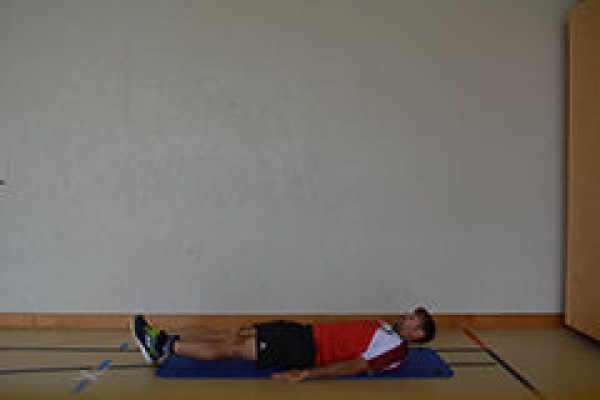


Lie on your back, upper body flat on the floor, arms stretched out to the side on the floor (or place your hands under your buttocks), bend your outstretched, raised legs to the side of your body (knees pointing diagonally upwards, feet by your buttocks) and return to the starting position (bend and stretch your legs and tilt them to the side). Switch sides after each exercise.
Attention:
Do not put your legs down completely, keep your (lower) back in constant contact with the floor (consciously tense your abdomen).
Lighten:
Do not fully extend your legs or always keep them bent (the smaller the angle, the easier).
Harden:
Additional weight on or between your legs.
2 weight cuffs/1 weight disc/(medicine) ball ► Make the exercise more difficult (additional weight)
Alternating lateral bending of one leg in forearm support ► plank crunch
Power
Individual work



Underarm support, alternately bend one leg and move the respective knee sideways towards the elbow (do not lower the knee).
Attention:
Head, torso, hips and knees practically form a line (do not stretch your buttocks upwards or let them sag, tense your stomach).
Lighten:
Lower the knees less far forward; only hold the position; place one knee on the floor and only exercise one side (organisation: = 2 exercises, left/right side).
Harden:
Additional weight (on the back or legs); unstable support for the arms.
2 weight cuffs/1 weight vest/weight disc/sandbag ► making the exercise more difficult (additional weight)
1 balance cushion/balance board ► making the exercise more difficult (unstable surface)
Bending the arms sideways and forwards alternately in prone position ► lying back extension
Power
Individual work






Lie on your stomach with your arms stretched out in line with your body. Hold the pistol in both hands and point it forwards (do not rest your arms on the floor), raise your legs slightly, transfer the pistol to one hand and bring both arms back and bend them next to your head (elbows at shoulder height). Raise your upper body slightly, extend your arms forwards again and grasp the gun with both hands and point it forwards. Then transfer the pistol to the other hand and repeat the exercise.
Attention:
Do not lower your upper body completely.
Lighten:
Just hold the starting position.
Variant:
Gather your arms behind your back as straight as possible and move them forwards again to the starting position.
1 pistol (neutralised)
Alternately lowering and raising the bent legs to the side in the supine position ► twisting windmill / half wipers
Power
Individual work
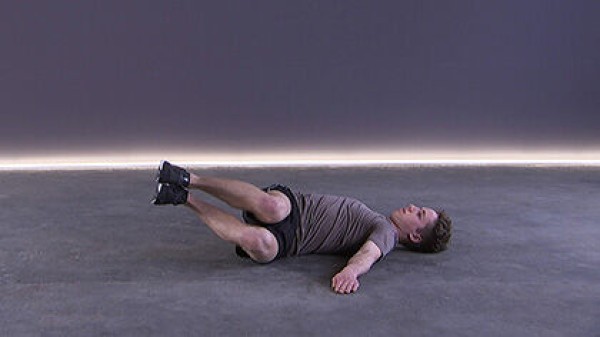

Lie on your back with your arms stretched out on the floor at shoulder height. Keep your legs together and bent in an upright position (thighs approximately 90 degrees, lower legs parallel to the floor), tilt your legs alternately to the left and right side (keep the angle of the legs constant).
Attention:
Do not put your legs down completely, keep your back in constant contact with the floor (consciously tense your abdomen, possibly place your hands under your back to control the position).
Lighten:
bend the legs more (knees closer to the body); only hold the position (without raising and lowering the legs) or lower the legs less.
Harden:
add weight to, between or on the legs; increase the angle of the legs (knees further away from the body) or even stretch the legs out.
2 weight cuffs/1 weight disc/(medicine) ball/sandbag ► Make the exercise more difficult (additional weight)
Lateral lowering and raising of the arms while standing
Power
Individual work


Stand upright, shoulder-width apart with your arms almost straight above your head in an upright position. Grasp the elastic band with your hands slightly wider than shoulder-width apart and, keeping your arms straight, lower your body sideways towards the T-position (squeeze your shoulder blades together) and return to the starting position.
Attention:
Do not arch your back (tense your torso), keep your shoulders deeply fixed/set.
Lighten:
Choose an elastic band with less resistance.
Harden:
Choose an elastic band with greater resistance.
1 elasticated rubber band
Lateral lowering and raising of the legs in supine position alternating ► twisting windmill / wipers
Power
Individual work

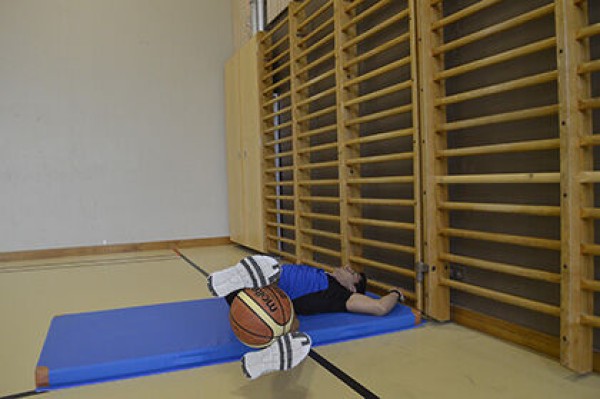
Lie on your back with your hands on a rung of the wall bars at head height. The legs are stretched out in an upright position and then moved from one side to the other towards the floor (you may need to wedge a ball between the legs).
Caution:
Do not lower your legs completely, keep them as straight as possible.
Make it easier:
Perform the exercise without the ball between your legs; lower your legs less.
Make it harder:
Add weight to your legs.
Variant:
In the centre position, lower your legs straight forwards and raise them back to the starting position.
1 wall bars
1 soft mat (small)
1 ball (e.g. football, volleyball, basketball)
2 weight cuffs/1 medicine ball ►Make the exercise more difficult (additional weight)
Lateral lowering and raising of the legs in supine position alternating ► twisting windmill / wipers
Power
Partner work



Trainee: Hold the legs of the standing partner in a supine position. Extend the legs vertically upwards and when the partner wants to push the legs towards the floor, hold against them/brake the downward movement so that the legs never touch the floor.
Partner: Hold the trainee's legs in a high position and push them sideways towards the floor.
Attention:
Always listen to/respond to your partner (adjust pressure/intensity). Keep your back in constant contact with the floor (no hollow back, consciously tense your stomach), do not put your legs down, keep your legs as straight as possible.
Lighten:
Just hold the position (legs stretched out in extension of the upper body), raise and lower your legs without additional impetus from your partner.
Harden:
Increased impulse from the partner; additional weight for the legs.
Variant:
The partner pushes the legs not only sideways but also frontally towards the floor (direction known to the exerciser or defined at random by the partner).
2 weight cuffs/ 1 (weighted) ball ► Make the exercise more difficult